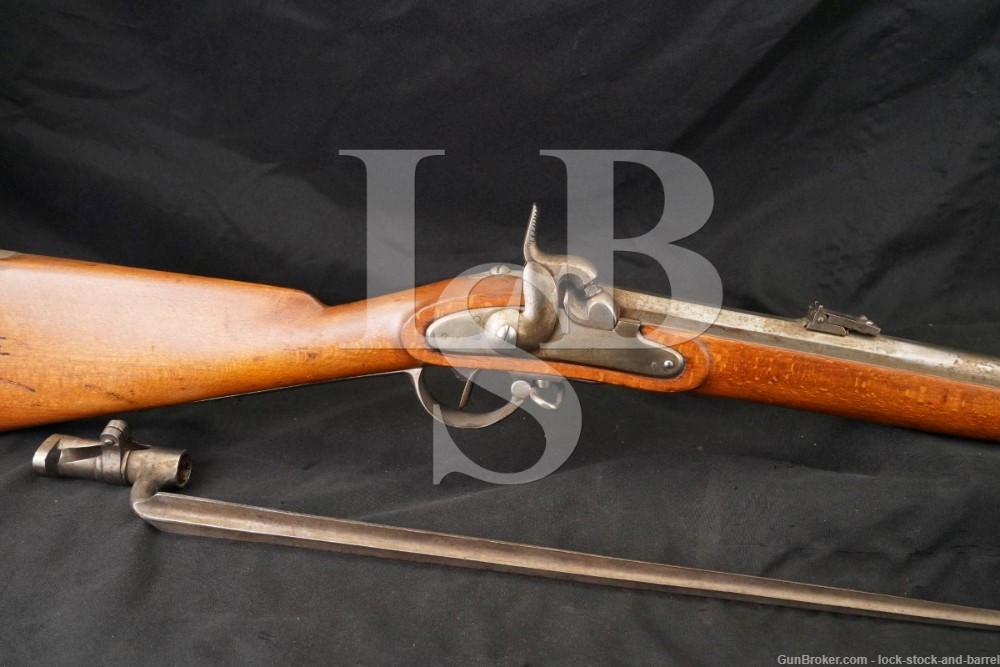
Ferdinand Früwirth Lorenz Rifle .547 Percussion Muzzleloader 1862 Antique
SOLD FOR: $2575
LSB#: 221026TG023
Make: Ferdinand Früwirth of Vienna
Model: Lorenz Model 1854
Serial#: NSN
Year of Manufacture: 1862, Antique
Caliber: 13.9mm (approximately .547 inches)
Action Type: Percussion Ignition Muzzle-Loaded Rifle-Musket
Markings: The lock-plate has a Habsburg double-headed eagle behind the hammer and is marked “862” (the date code) ahead of the hammer. The side-plate is marked “23” above “P”. The top of the chamber is marked with the maker’s mark “FERD / FRUWIRTH”. The left side of the barrel bands and nose-cap are marked “23” above a “P”. The rear sight’s base and the portion of the barrel adjacent to the rear sight are both marked “24”. The right side of the butt is marked “R.E”.
Barrel Length: 952mm (Approximately 37.5”)
Sights/ Optics: The front sight is a blade fixed by the muzzle. The rear sight is a dovetailed two-position sight. The rear sight presents a low profile V-notch in the down position, when raised the sight presents three V-notches: one at the top marked “8”, one on the upper portion of the sight marked “6” and one at the center marked “5”.
Stock Configuration & Condition/ Grip: The stock is one-piece wood featuring a nose cap with a fixed ferrule at the bottom which is secured by a spring, two barrel bands secured by springs (the forward barrel band has a fixed sling swivel at the bottom), a slot in the forend for the included ramrod, a lock-plate opposite a side-plate, a sling swivel at the front of the trigger guard, a straight wrist, a straight comb with cheek-piece and metal butt-plate. The stock has some light handling marks, nicks and scuffs. Notably, there is a light nick ahead of the rear barrel band on the left side, a light crack at the tip of the top-tang, light wear surrounding the lock-plate and there is some discoloration including several patches around the side-plate. The LOP is 13” from the trigger to the rear of the butt-plate. The butt-plate is coated in light-moderate surface oxidation and has light handling wear. Overall, the stock is in Very Good condition for an Antique.
Type of Finish: Bright
Finish Originality: Original
Bore Condition: The bore is semi-bright with sharp rifling. There is scattered light erosion concentrated in the grooves.
Overall Condition: The rifle-musket has no surviving metal finish. The gun is coated in scattered patches of light surface oxidation but is still somewhat bright. There are some light handling marks, nicks and scuffs. Notably, there is light pitting surrounding the nipple/cone assembly and light wear along the leading edges. The markings remain mostly clear. Overall, the rifle-musket is in Very Good condition for an Antique.
Mechanics: The action functions correctly. We have not fired this musket. As with all previously owned firearms, a thorough cleaning may be necessary to meet your maintenance standards.
Box Paperwork and Accessories: The gun comes with an appropriate Model 1854 Lorenz Socket bayonet. The bayonet has some scattered light oxidation, but it remains in Very Good condition.
Our Assessment: The Lorenz Rifle-Musket was designed by Austrian military officer Joseph Lorenz and was approved for service in 1854. Austrian military demand for the modern rifle-musket exceeded the capabilities of Austrian state arsenals, thus the manufacture of the Lorenz was also subcontracted to a number of private Austrian manufacturers (this gun was made by Ferdinand Früwirth, a Vienesse gunsmith). The gun was chambered for a unique Austrian round based on Wilkinson solid base bullet, it was not designed to chamber the larger British .577 caliber based on the French Minie bullet that was used on most rifle-muskets of the day or the .69 caliber ball used by older smoothbore muskets. The Lorenz underwent some minor modifications in 1862 including a larger caliber that chambered the standard Minié balls (.58 caliber) but this is one of the older Lorenz Rifle-Muskets that was made prior to the upgrade.
The Lorenz saw its first action in 1859, it was issued to Austrian forces sent to fight against Savoyard and French forces during the Second Italian War of Independence. The war resulted in a humiliating defeat for Austria which was forced to cede territory to both Sardinia and France. The Lorenz would later be sold in large numbers to both the Confederacy and Union during the American Civil War, with over 200,000 sold to the North and 100,000 to the South. The gun’s last major usage would be during the Austro-Prussian War (ca. 1866), during the conflict Prussian forces equipped with breech-loaded Dreyse Needle Rifles completely out-classed Austrian forces equipped with muzzleloaders. The ensuing Austrian defeat can at least be partially attributed to the superiority of the breech-loaded rifles over muzzleloaders. Subsequently, powers across Europe adopted breech loaded firearms and Austria responded with the introduction of the Wänzl conversion, designed by Austrian arms designer Franz Wänzl, in 1867 (about a year after the conflict with Prussia) which was built by converting surplus muzzleloaders into breech-loaded rifles (not entirely dissimilar from the Erskine S. Allin’s Trapdoor Rifle and Jacob Snider’s namesake breech-loading system). The age of the muzzleloader had ended.
This particular specimen is a Lorenz Model 1854 rifle-musket that was made before the gun’s were assembled with larger caliber barrels. The stock has a marking on the butt, unfortunately we have no clue what it means or when it was added. Otherwise, the Austrian markings remain nicely preserved. The mechanics remain solid and this gun ought to make a great addition to any historical firearms collection. Good luck on your bid!
